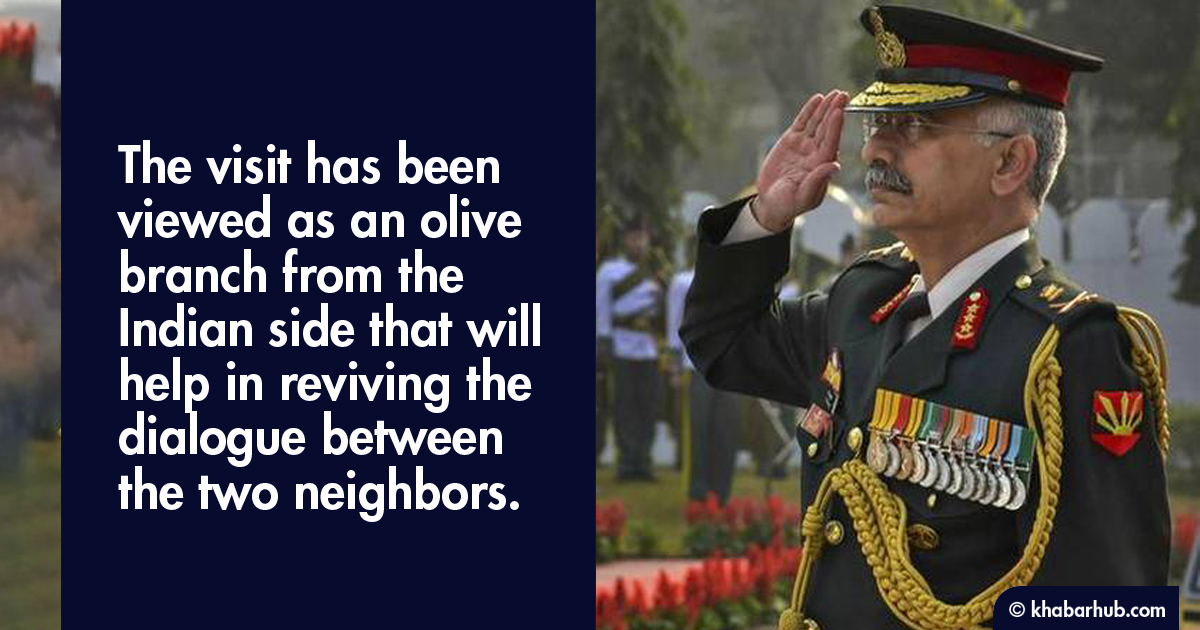KATHMANDU: Indian Army Chief General Manoj Mukund Naravane’s visit to Nepal on November 4 has been viewed as an ice-breaker, which Nepal and India take it as a positive indication to normalize the cracked relations between the two countries after the Kalapani, Lipu Lekh and Limpiyadhura border dispute.
The three-day visit, as observers note, has been viewed as an olive branch from the Indian side that will help in reviving the dialogue between the two neighbors.
General Naravane is visiting Nepal at the invitation of Nepal Army Chief General Purna Chandra Thapa.
His visit is seen as meaningful at a time when Nepal’s Prime Minister KP Oli recently reshuffled the cabinet with PM Oli himself assuming the charge of the Ministry of Defense. Observers say India has taken this as a positive signal amid a standoff between the two countries.
The cabinet had approved the visit in February this year but was postponed due to the lockdown after the outbreak of the coronavirus pandemic.
This means that Naravane’s visit will be more than a routine affair or just a courtesy call since an understanding between the two armies is vital to resolve the border dispute.
During his visit, General Naravane will be conferred with the honorary rank of the commander to the army chief of Nepal – a historic tradition of the Army of conferring the honorary title of the commander to each other’s army chiefs.
Nepal’s President Bidya Devi Bhandari will confer the Indian Army Chief with the honorary rank.
It should be noted that Nepal’s General Purna Chandra Thapa, too, had received a similar honorary ranking by India in January 2019.
Naravane’s three-day-visit to Nepal is also likely to further strengthen security, defense, and overall ties with Nepal.
Besides exchanging views to creating an environment for talks between the two countries, this visit is also likely to carry a symbolic meaning as Nepal will have an opportunity to comprehend India’s position on the border disputes as well as conveying Nepal’s stance to the Indian side.
This means that Naravane’s visit will be more than a routine affair or just a courtesy call since an understanding between the two armies is vital to resolve the border dispute.
Even today, the Indian Army continues to recruit Gurkhas from Nepal to serve in its various battalions. Popular for the valor and fierce loyalty, the Gurkhas have long been an integral part of the Indian Army.
In fact, there are instances in the past how armies of Nepal and India have come together to improve the bilateral relations.
The NA and the Indian Army have long-standing cooperation with the bilateral defense cooperation including assistance to NA in its modernization through the provision of training and equipment.
Meanwhile, Nepal Army procures military hardware including lethal weapons from India at a concessional price.
Furthermore, the Indian Army and the Nepali Army have had close links and a strong bond that started as early as 1809 with soldiers from Nepal (the Gurkhas) serving in the army of India’s Maharaja Ranjit Singh.
Even today, the Indian Army continues to recruit Gurkhas from Nepal to serve in its various battalions. Popular for the valor and fierce loyalty, the Gurkhas have long been an integral part of the Indian Army.
Even though the exact number of Gurkhas in the Indian army is not clear, it has been estimated that more than 26,000 Nepali Gurkhas are currently serving in the Indian Army.
The latest development signals that relations between the two countries will be back on track.









Comment